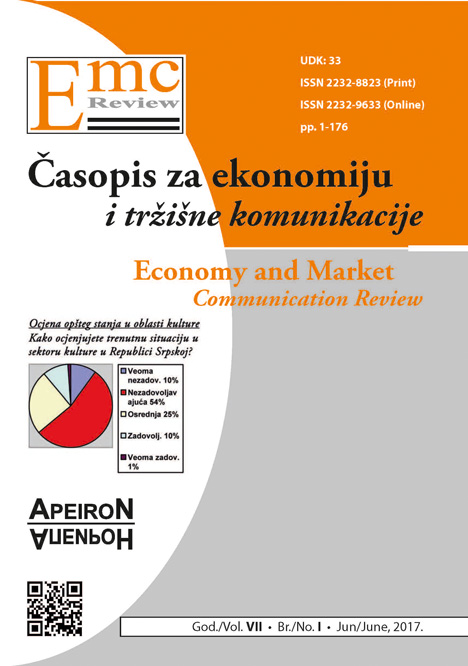MARKETING ANALYTICS IN THE FUNCTION OF DECISION MAKING IN BANKS / MARKETING ANALITIKA U FUNKCIJI DONOŠENJA ODLUKA U BANKAMA
DOI:
https://doi.org/10.7251/EMC1701093SAbstract
In this paper we have presented analytics as a crucial factor in marketing decision making. The banking environment is turbulent and complex today. The client is well educated and his needs are constantly changing. He has access to lot of information and has power of choice. His digital expectations are high: he needs to access banking products and services from any place and at any time. Also, the client is leaving data everywhere: in bank`s database and at different internet sites. As data are comparative advantages today, the bank is eager to collect them in order to analyze data and make marketing decisions. Analytics is helping bank in this new era of doing business. Analytics assumes analysis, interpretation and communication of understandable patterns in the data. It relies on mathematics and statistics techniques in order to find new knowledge and meaning of existing data. There are many analytics techniques which are based on algorithms and databases. Depending on which problem a bank needs to solve or what it aim wants to achieve, the bank uses one or more analytical techniques. Survival Analysis, Nearest Neighbor Classification, Neural Network, Logistic Regression and Decision Tree are the most common techniques used in banking sector.
Marketing analytics models support marketing decisions. Marketing models enable bank to predict outcome (e.g. if a client is likely to leave) or to identify differences between group of clients. In order to achieve results, the bank has created different marketing models such as Response Models, Queues, Retention Models, Market Basket Analysis, and Win-Back Models. Marketing models are helping the bank to predict if the client will answer on offer which bank is offering through marketing campaigns. The aim of these models is to create target group of clients or segment with likelihood to increase their relationship with the bank.
In order to create marketing model, the bank defines the aim which it wants to achieve. Usually, the bank wants to keep most profitable clients and to decrease costs. After defining the aim of marketing model, the bank collects, analyses and transforms data needed for creation of the model. Also, it is necessary to estimate data quality. If data are no longer of high quality, there can be issue with model results. Also, the bank has to take into consideration the volume, velocity and variety of data. Large data are collected from lots of data sources and stored in data warehouse or data marts using modern technologies. Model technologies help to convert data into valuable information which can be used for making decisions. After creation of a model, it is necessary to estimate its accuracy, comprehensibility and level of confidence in results given by the model. Also, every model has to be managed (quarterly or yearly) in order to test if the results are still valid or it has to be changed with a new model.
Analytics gives competitive advantages to the bank. It can improve effectiveness of processes and organization and improve efficiency in making marketing decisions. The bank as a profit oriented organization tends to contact profitable customer in order to increase their value through customer lifetime value. In this way, the bank has a possibility to invest in relationship with clients which can be valuable in the long run. Analytics gives knowledge about the customer. It helps to discover pattern in large amount of data. The contribution of analytics can be seen in decreasing marketing costs by identifying clients who are likely to respond on marketing campaigns. Also, it contributes in pricing, channel management, selling, segmentation and product development. Today, text analytics is also important for banking business, as lots of data are unstructured and can be found in form of documents, blogs, video sharing and comments on internet sites. In order to use this kind of data, text analytics helps the bank to understand data and read them with certain limitation. However, there are also challenges which the bank faces when implementing analytics. Limited budget, employees without necessary skills for the development of models, poor quality of data, inadequate and unintegrated softer tools, problems with protection of client data as well as imprecisely defined aim of model can be resulted in unsatisfactory realization and poor position of analytics in the bank. In order to overcome these challenges, the bank needs to set up a strategy of analytics and to link it with all the internal processes in organization.
